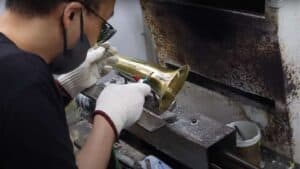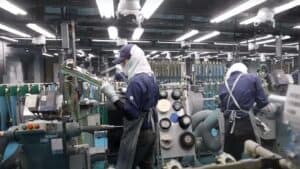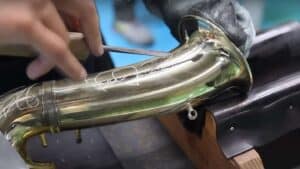
How Yamaha Makes Saxophones (Mostly) By Hand
- By Jay Metcalf
- General Saxophone Topics, Saxophone Repair and Maintenance

Check out the audio podcast version of this post on Apple Podcasts or Spotify.
Visiting the factories where my favorite musical instrument gets made by hand is super exciting, but as I found out later, there are very few people who have ever visited all 3 of the most important factories of our time, Selmer in Paris, Yanagisawa in Tokyo and Yamaha in Hammamatsu Japan.
And I’m probably the only person to ever do so in the space of 1 month.
I didn’t plan it that way, it just sort of happened.
How I Visited 3 Saxophone Factories in a Month
First I got invited by Selmer and went to Paris to visit their historic factory where the most legendary saxophones ever have been produced for over 100 years. Then I got invited to tag along with two of my favorite saxophone players, Vincent Herring and Eric Alexander, during their summer tour in Japan.
On the first day of my visit, my friends at Yanagisawa were kind enough to give me a tour of their factory. Yamaha’s band instrument factory is located in Hamamatsu, Japan which is about two hours by bullet train from Tokyo, so I was lucky enough to be able to visit them during my stay in Japan.
Both the Selmer Paris and Yanagisawa tour videos are on the Youtube channel and I’ve included links for both. Believe it or not, I’m actually working on more factory tour videos that you’re not going to want to miss so make sure you are subscribed to the channel.
It is fascinating to be able to see in detail, how these 3 companies can all produce amazing saxophones while each one has its own individual systems, processes and style of manufacturing.
Yamaha’s Facility
When I got to the factory, I met with the head designer of saxophones for Yamaha, Yasu Uchiumi. Before the tour started I tried to get him to spill some secrets, like maybe there is something new coming from Yamaha saxophones? There seemed to be a bit of a hint that there would be.
When you step into the facility, there is a rush of air that you can hear and feel. The huge building is fully climate controlled. It is a very large and seriously well-organized factory that’s been in operation since 1970.
Hand Hammered Saxophone Bells
The first stop on our tour is perhaps the thing Yamaha is most proud of and that is the hand-hammering of the saxophone bells. Well, to be fair there is a robot that helps with some of the hammering too.
We observed a worker who was hand hammering Yamaha’s one piece bells. These bells are made out of a single sheet of brass that gets soldered together along one seam. These bells are reserved for Yamaha’s highest end professional Custom model EX and Z saxophones.

Hand Hammering a Yamaha Saxophone Bell
The one piece bells start out in this very rough and squarish shape. Our friend is going to hammer it into a more shapely saxophone bell. He spends about 5 minutes on each one. At another station, the flared part of the bell gets further refined and smoothed out.
Yamaha has another process for making saxophone bells for their other less expensive models. Those bells start out as 2 separate pieces. The 2 halves get soldered together and then shaped precisely using a super high pressure hydraulic blast.
On to the next step…
Soldering a Saxophone
There are a ton of metal posts that need to get soldered onto the saxophone bodies. These will hold the keys in place.

Soldering a Yamaha Saxophone Bell
The extreme heat of that process turns the brass a red color. Then a worker loads the saxophone bells into a large machine that will clean them. They come out looking shiny.
A saxophone body tube has a lot of holes in it. They start out as an oval shape. Then the body tube is put on a mandrel which has steel half-spheres loaded inside it.
The spheres get threaded and then pulled out by the machine to make perfectly round tone holes. First the left hand stack, then the right.
Buffing the Parts of a Saxophone
Before we assemble a saxophone and put on the finishing touches, a lot of buffing needs to be done. This process makes the brass smooth and removes any scratches or imperfections that may have occurred.
Yamaha’s buffing room is no joke.

Yamaha’s Buffing Room
Hand Engraved Saxophone Bells
They also takes a lot of pride in their hand engraved bells. While each model has it’s own design pattern, no two will be exactly alike.

Hand Engraving of a Yamaha Saxophone Bell
Once the parts have been buffed, it’s time to apply the lacquer. First they have to be meticulously cleaned though and that’s what this worker is doing to these Baritone saxophone bells.
If you’ve ever wondered how they get the engraving to show so perfectly on the black lacquer horns, the black lacquer goes on first, then they get engraved, then they get cleaned and a coat of gold lacquer is applied on top.
The lacquer gets applied by hand with a spray gun first, then by the machine. Doesn’t that machine give you a sort of 1970s Godzilla movie vibe?
Assembling a Saxophone
Next we head upstairs to the final assembly area. At each of these stations, technicians complete a specific part of the assembly.
One station might be for the palm keys, another might be for the bell keys. One person is installing and regulating the pads for the right hand keys.

Assembling a Yamaha Saxophone
In Yamaha’s assembly process, the technician who does the final step is also responsible for play testing that instrument. So in the very large assembly room, you hear saxophones, clarinets, flutes, oboes playing all the time.
We watched a technician play testing a saxophone who seemed a little embarrassed that I was filming him playing, but he and all the others I heard are very strong musicians that really understand what the instruments are meant to sound like.
Thank You to Yamaha
I want to thank Yamaha for inviting me into their factory and showing me around. It was an honor for me to be allowed to film their process and share it with you.
What I’ve learned from visiting these 3 factories is that there is more than one way to make a great saxophone and getting that close up look at the processes really helps us better understand some of the differences between the various brands and how much actually goes into making our favorite instrument.
Make sure you check out my Selmer Paris and Yanagisawa Factory tour videos next.
More Posts
Jay Metcalf
Leave a Comment
Your email address will not be published. Required fields are marked *
COURSES FOR
EVERY LEVEL
filter by difficulty using the tabs
- All
- Advanced
- Beginner
- Bundle
- Free
- Intermediate
- All
- Advanced
- Beginner
- Bundle
- Free
- Intermediate







One Comment
I’ll be going to Japan late July 2025. Where exactly is the Yamaha Saxophone Factory?